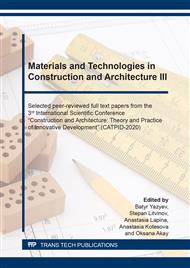[1]
V.A. Kochetov, Roman concrete, Stroyizdat, Moscow, (1991).
Google Scholar
[2]
V.I. Solomatov, M.K. Takharov, Taher Shah Md., Intensive technology of concrete, Stroyizdat, Moscow, (1989).
Google Scholar
[3]
St. A.Yu. Murtazaev, M.Sh. Salamanova, M.S. Saidumov, Z.Kh. Ismailova, The effect of surface's active sites on the reactivity of mineral additives, Scientific journal Modern Science and Innovation, (Stavropol - Pyatigorsk). 2 (18) (2017) 168-175.
Google Scholar
[4]
St. A.Yu. Murtazaev, M.Sh. Salamanova, Prospects for the use of thermally activated raw materials of aluminosilicate nature, Volga Scientific Journal. 2 (46) (2018) 65–70.
Google Scholar
[5]
S- A. Yu. Murtazayev, M.Sh. Salamanova, A. Alashanov, Z. Ismailova, Features of Production of Fine Concretes Based on Clinkerless Binders of Alkaline Mixing (Features of obtaining fine-grained concrete based on clinker-free alkaline binders) 14th International Congress for Applied Mineralogy (ICAM 2019) Belgorod State Technological University named after V. G. Shukhov, 23–27 September 2019, Belgorod. (2019) 385-388.
DOI: 10.1007/978-3-030-22974-0_93
Google Scholar
[6]
M.M. Mayants, The use of ash and slag from hydroelectric power plants in the building materials industry, Obzor, Moscow, (1970).
Google Scholar
[7]
H.P. Rakhimova, Status and perspective directions of development of research and production of composite slag-alkali binders, mortars and concrete, Building materials. 9 (2008) 77-80.
Google Scholar
[8]
D. Hardjito, S. Wallah, D. Sumajouw, B. Rangan, On the development of fly ash-based geopolymer concrete, ACJ Materials Journal. 101 (6) (2004) 467-472.
DOI: 10.1007/s10853-006-0523-8
Google Scholar
[9]
G.S. Rostovskaya, I.P. Chernobaev, The raw material base of slag alkali cements, Cement. 11 (1985) 20.
Google Scholar
[10]
Yu.A. Sidorenko, Improving the resistance of slag-alkali binders and concrete against vysolobrazovaniya: abstract. dis. ... cand. tech. Sciences, Kiev, (1991).
Google Scholar
[11]
P.V. Krivenko, The operational properties of concrete on slag alkali cement, Kiev, 4 (1980).
Google Scholar
[12]
J. Davidovitz, Geopolymer. Chemistry and applications. Saint-Quentin: Institute Geopolymer. (2008).
Google Scholar
[13]
J. Davidovits, Geopolymer Chemistiy and Properties, Proceed. 1st Europ.Conf. on Soft Mineralurgy Geopolymer 88,, France (1988).
Google Scholar
[14]
A. Garcia-Luna, H. Minard, C. Prieto-Gomez, C. Soare, M. Viviani, Microsilextm a new material to improve environmental performance of cement and concrete, Proceed. 3rd International Symposium Non-traditional cement&concrete, (Bmo).
Google Scholar
[15]
V.D. Glukhovsky, V.A. Pakhomov, Slag-alkali cements and concrete, Budivelnik Kiev, (1978).
Google Scholar
[16]
V.D. Glukhovsky, I.A. Pashkov, B.C. Grigoryev, Complex use of blast furnace and electrothermophosphoric slag in the production of high-strength cements and concrete [Text] / V.D. Glukhovsky, University News: Construction and Architecture. 5 (1980) 62-66.
Google Scholar


